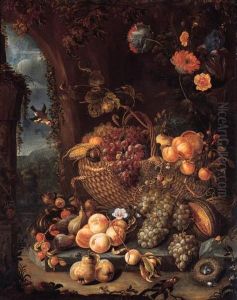Hendrick Schoock Paintings
Hendrick Schoock, a lesser-known figure in the pantheon of Dutch Golden Age painters, was born in 1620. His life and career unfolded during a period renowned for its remarkable artistic achievements in the Netherlands, a time when art was flourishing under the patronage of a burgeoning middle class and the influence of Humanism. Despite the scarcity of detailed records about Schoock's personal life and training, it is believed that he was part of the vibrant artistic environment of the 17th century, which was characterized by a keen observation of nature, everyday life, and an emphasis on light and shadow.
Schoock's oeuvre, although not as extensively documented or studied as that of his more famous contemporaries like Rembrandt or Vermeer, suggests he was adept in genres that were popular among Dutch artists of the time, such as still life, landscape, and genre scenes. His work, according to the limited sources available, demonstrated a meticulous attention to detail and a commitment to realism, qualities that were highly prized in Dutch Golden Age painting. Like many artists of his era, Schoock would have been influenced by the prevailing artistic trends and the socio-economic conditions of 17th century Netherlands, which saw a burgeoning interest in art collecting among the middle class and a preference for themes that reflected the values and realities of Dutch society.
Despite the achievements of his career, Hendrick Schoock's legacy has been somewhat eclipsed by the towering figures of his time. His death in 1665 marked the end of a career that, while perhaps not groundbreaking, contributed to the rich tapestry of Dutch art. Today, his works, when they do emerge, offer valuable insights into the diversity and depth of talent that defined the Dutch Golden Age. As art historians continue to unearth and reevaluate the contributions of artists like Schoock, our understanding of this pivotal era in art history becomes more nuanced and comprehensive.


